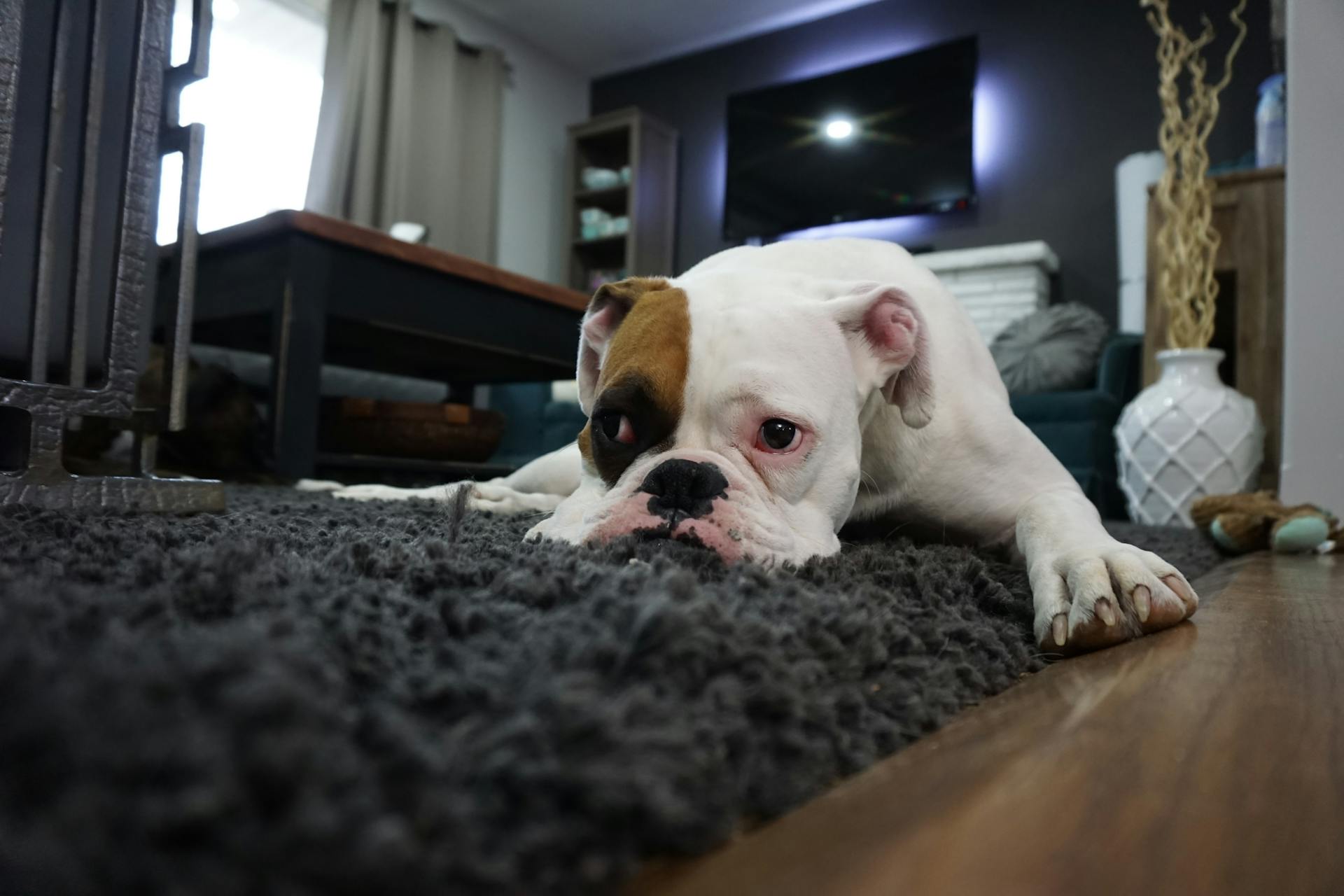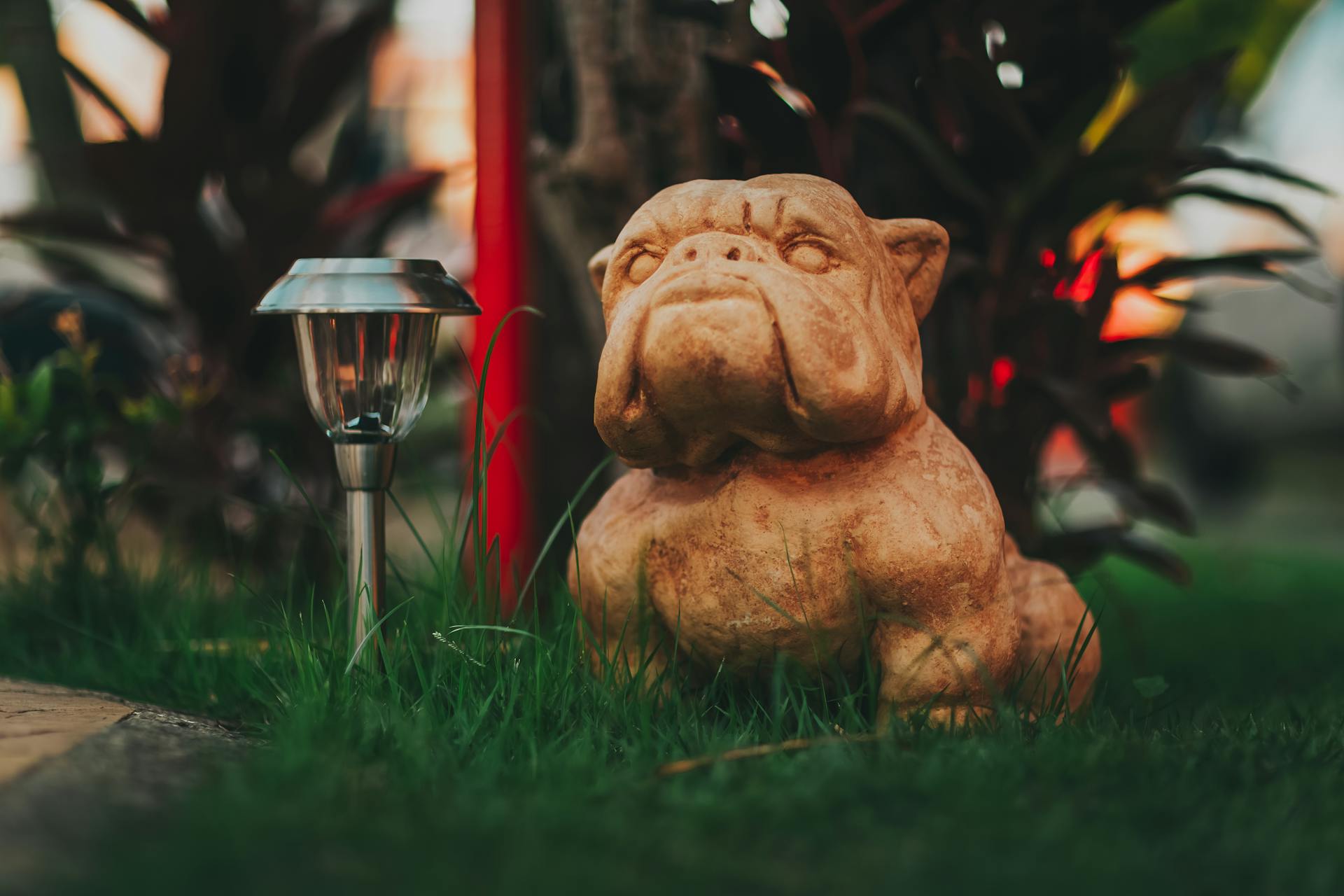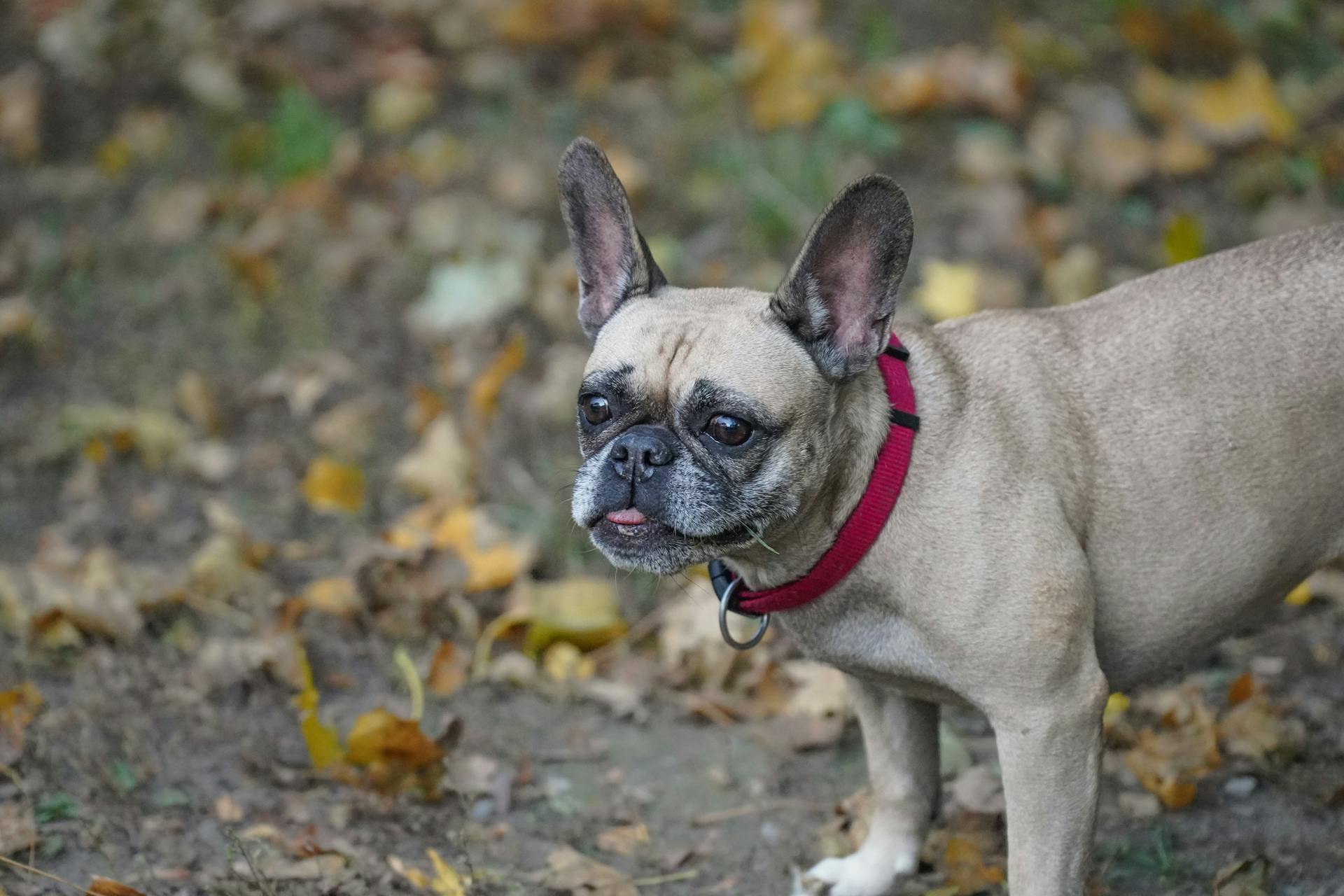
English Bulldogs are prone to a unique condition called reverse sneezing, also known as inspiratory paroxysm.
This condition causes the dog to make loud, high-pitched sounds, often accompanied by flailing of the head and neck.
In English Bulldogs, reverse sneezing can be triggered by nasal mucus, allergies, or even excitement.
It's essential to remain calm and patient when your English Bulldog is experiencing a reverse sneezing episode, as this can help to reduce the dog's stress and anxiety levels.
What Is Reverse Sneezing?
Reverse sneezing, also known as inspiratory paroxysm, is a common phenomenon in English Bulldogs. It's characterized by sudden, forceful inhalations through the nose.
During an episode, a dog may stand, stretch, or even jump up and down to try to clear its airway. English Bulldogs are prone to this behavior due to their brachycephalic skull structure.
The airway of an English Bulldog is more constricted than that of other breeds, making it more susceptible to obstruction. This can cause the dog's airway to become inflamed and irritated.
A reverse sneeze can be triggered by a variety of factors, including nasal mucus, allergies, or even a piece of food getting stuck in the dog's airway.
Causes and Symptoms
English bulldogs are prone to reverse sneezing due to their brachycephalic (short-headed) breed. This can cause a narrowing of the trachea and difficulty getting air into the lungs.
The symptoms of reverse sneezing in English bulldogs are quite alarming, but they usually clear up within a minute or two. They include gasping, difficulty drawing air, an extended neck, and a snorting sound.
Some common causes of reverse sneezing in English bulldogs include allergies, eating or drinking too fast, foreign bodies, mites, pressure on the throat, and viruses. You can also look out for these potential irritants:
- Allergies
- Eating or drinking too fast
- Foreign bodies
- Mites
- Pressure on throat (often from pulling on leash)
- Viruses
What Does a Reverse Sneezing Sound Like?
A reverse sneeze in a dog sounds like a sort of snorting and coughing sound.
During these episodes, dogs make a sound that can be loud, similar to goose-honking in some cases.
They may also breathe in rapidly, which can sound as though they've got something stuck in their throat.
The episode will be over shortly, and your dog is probably fine despite the loud noise.
Suggestion: Collapsing Trachea Dog Sound
Causes of Reverse Sneezing
Reverse sneezing in dogs is a common phenomenon that can be caused by a variety of factors. Allergies can lead to an episode of reverse sneezing, as can eating or drinking too fast, foreign bodies, mites, and pressure on the throat.
Some common irritants that can cause reverse sneezing include dust, pollen, and perfumes. These can irritate the nasal passages and throat, leading to a reverse sneeze. I've seen this happen to my own dog when we're out on a walk and he sniffs something he shouldn't.
Other potential causes of reverse sneezing include viruses, overexcitement, and air fresheners or scented candles. These can all irritate the throat and nasal passages, leading to a reverse sneeze.
Some breeds are more prone to reverse sneezing due to their physical characteristics. Short-headed breeds, such as Pekingese, Pugs, French Bulldogs, Bulldogs, and Shih Tzus, are more likely to experience reverse sneezing. This is because their narrow nasal passages can make it harder for them to breathe.
Intriguing read: Dog Nasal Tumor Reverse Sneezing
If your dog is overweight, they may be more likely to experience reverse sneezing. This is because extra fatty deposits around the neck area can cause difficulty breathing.
Here are some common causes of reverse sneezing in dogs:
- Allergies
- Eating or drinking too fast
- Foreign bodies
- Mites
- Pressure on throat
- Viruses
- Dust
- Pollen
- Perfumes
- Air fresheners or scented candles
- Overexcitement
- Narrow nasal passages
- Overweight
Symptoms of Reverse Sneezing
Reverse sneezing in dogs can be a concerning sight, but understanding the symptoms can help you identify the issue. A reverse sneeze can appear at first glance like a dog is choking.
During an episode, a dog will often extend its neck and gasp with an alarming snorting sound. This sound is a key indicator of a reverse sneeze. The elbows are often turned out, and the eyes bulge as the dog struggles to get air into its lungs due to the narrowing of the trachea.
Some common symptoms of reverse sneezing include:
- Gasping
- Difficulty drawing air
- Extended neck
- Snorting
It's essential to note that these symptoms usually clear up within about one to two minutes, with no ill effects. However, if your dog is experiencing reverse sneezing on a regular basis, it's crucial to visit a veterinarian to rule out other conditions, such as tracheal collapse.
Diagnosis and Treatment
If your English bulldog is experiencing reverse sneezing episodes, it's essential to determine the underlying cause. A thorough physical examination by your veterinarian will check the nasal passages, mouth, and throat areas to rule out conditions such as nasal cancer, mites, or polyps.
Your vet may perform a rhinoscopy to examine the nasal passages more closely. They may also collect a sample from the nasal passages for biopsy to confirm the presence of any growths or tumors.
In some cases, your vet may recommend blood tests to check your dog's blood count and chemistry, as well as a urinalysis to rule out other underlying health conditions. If your vet suspects allergies or mites are the cause, they'll work with you to develop a treatment plan to address these conditions.
Check this out: English Bulldog Vet
How Vets Diagnose Reverse Sneezing
If your dog's symptoms are concerning, a veterinarian will perform several tests to confirm there are no underlying causes to the behavior. A thorough physical examination will be completed, checking the nasal passages, mouth, and throat areas thoroughly.
A rhinoscopy may be completed to see if any mites, polyps, or tumors are present in the nasal passages. A sample from the nasal passages may also be taken for biopsy to rule out nasal cancer.
Your veterinarian will ask for information about the duration and frequency of symptoms, as well as any concurrent medications your pet is being given. They may also ask for a video recording of an episode to assist in the diagnosis.
A thorough physical exam will be performed to search for medical issues that could be causing your dog's sneezing. This may include checking for nasal discharge, difficulty breathing, and issues with the heart and lungs.
Depending on your pet's medical history and clinical signs, your veterinarian may recommend blood work, X-rays, or allergy tests to rule out possible causes.
Here are some potential underlying issues that may be checked for:
Treatment Options for Reverse Sneezing
If your dog is experiencing an episode of reverse sneezing, try channeling the air through their mouth by closing off their nostrils with your hand for a few seconds.
Most reverse sneezing episodes are mild and infrequent, but if you suspect an underlying cause like allergies or mites, you'll need to address that condition to reduce the frequency and intensity of episodes.
To help shorten an episode, you can softly blow in your dog's face, gently massage their throat, or hold their nostrils closed for a few seconds.
Airborne allergens like pollen, perfume, and cleaning sprays can irritate your dog's nostrils, so try to identify and avoid these triggers.
Seasonal changes in humidity and temperature can also prompt a reverse sneezing event, and using a humidifier or heater in your pup's favorite space may help.
If your dog wolfs down their food, consider using a food puzzle toy to slow down their eating, which can also help reduce the likelihood of reverse sneezing episodes.
If you feel the need to do something for your dog, you can try massaging their throat to stop the spasm, or briefly covering their nostrils with a hand to force them to swallow and remove the irritant.
See what others are reading: Kennel Cough or Something Stuck in Throat
Recovery and Care
If you have an English Bulldog prone to reverse sneezing, there are steps you can take to reduce occurrences. Certain breeds, including English Bulldogs, are more likely to develop this disorder, especially if they're short-nosed.
Reducing chaos and excitement in your dog's environment can help minimize reverse sneezing episodes. This might mean keeping playtime and social interactions to a minimum, at least until your dog is feeling more relaxed.
Using a harness or halter lead on walks instead of a traditional collar can also make a difference. This can help reduce irritation and discomfort that might trigger a reverse sneeze.
Here are some additional tips to help your English Bulldog feel more comfortable:
- Buying bowls designed to slow down eating speeds
- Reducing levels of dust and dander in the house.
In most cases, a reverse dog sneeze doesn't need any kind of treatment, and it will pass pretty quickly. However, if your dog is struggling, there are a few things you can try to help calm him down.
To help treat a dog reverse sneeze, you can try holding your dog's nostrils closed for a moment or lightly massaging or petting your dog's throat.
Frequently Asked Questions
How to stop bulldog reverse sneezing?
Gently stroking your bulldog's neck or head can help calm them during a reverse sneezing episode, while offering a drink or something to lick may stimulate swallowing and help clear out the irritant.
Sources
- https://wagwalking.com/condition/reverse-sneezing
- https://resources.integricare.ca/blog/dog-reverse-sneeze
- https://blog.healthypawspetinsurance.com/reverse-sneezing-in-dogs
- https://www.trupanion.com/pet-blog/article/reverse-sneezing-in-dogs
- https://www.lonetreevet.com/blog/the-reverse-sneeze-what-it-is-and-when-to-worry/
Featured Images: pexels.com


